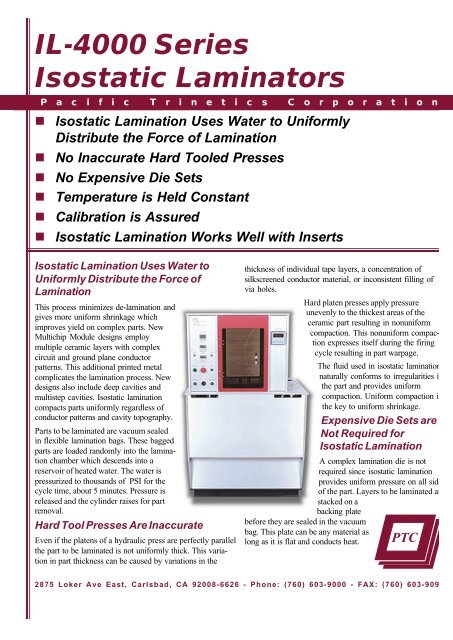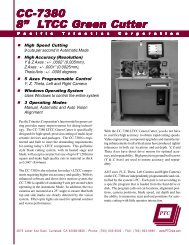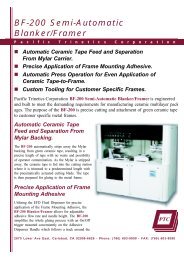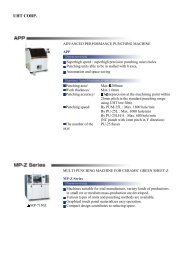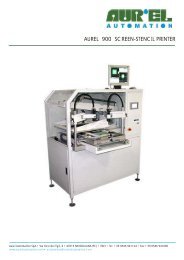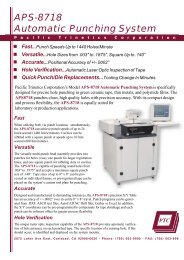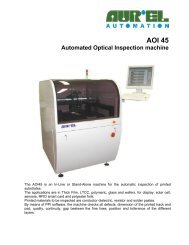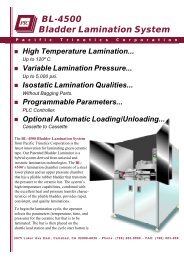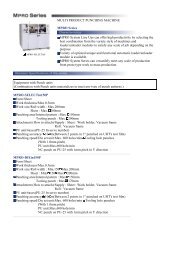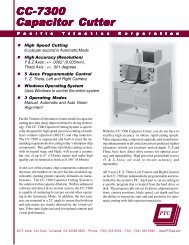C:\KARO\Produkte\PTC\data sheet
C:\KARO\Produkte\PTC\data sheet
C:\KARO\Produkte\PTC\data sheet
You also want an ePaper? Increase the reach of your titles
YUMPU automatically turns print PDFs into web optimized ePapers that Google loves.
IL-4000 Series<br />
Isostatic Laminators<br />
P a c i f i c T r i n e t i c s C o r p o r a t i o n<br />
� Isostatic Lamination Uses Water to Uniformly<br />
Distribute the Force of Lamination<br />
� No Inaccurate Hard Tooled Presses<br />
� No Expensive Die Sets<br />
� Temperature is Held Constant<br />
� Calibration is Assured<br />
� Isostatic Lamination Works Well with Inserts<br />
Isostatic Lamination Uses Water to<br />
Uniformly Distribute the Force of<br />
Lamination<br />
This process minimizes de-lamination and<br />
gives more uniform shrinkage which<br />
improves yield on complex parts. New<br />
Multichip Module designs employ<br />
multiple ceramic layers with complex<br />
circuit and ground plane conductor<br />
patterns. This additional printed metal<br />
complicates the lamination process. New<br />
designs also include deep cavities and<br />
multistep cavities. Isostatic lamination<br />
compacts parts uniformly regardless of<br />
conductor patterns and cavity topography.<br />
Parts to be laminated are vacuum sealed<br />
in flexible lamination bags. These bagged<br />
parts are loaded randomly into the lamination<br />
chamber which descends into a<br />
reservoir of heated water. The water is<br />
pressurized to thousands of PSI for the<br />
cycle time, about 5 minutes. Pressure is<br />
released and the cylinder raises for part<br />
removal.<br />
Hard Tool Presses Are Inaccurate<br />
Even if the platens of a hydraulic press are perfectly parallel<br />
the part to be laminated is not uniformly thick. This variation<br />
in part thickness can be caused by variations in the<br />
thickness of individual tape layers, a concentration of<br />
silkscreened conductor material, or inconsistent filling of<br />
via holes.<br />
Hard platen presses apply pressure<br />
unevenly to the thickest areas of the<br />
ceramic part resulting in nonuniform<br />
compaction. This nonuniform compaction<br />
expresses itself during the firing<br />
cycle resulting in part warpage.<br />
The fluid used in isostatic lamination<br />
naturally conforms to irregularities in<br />
the part and provides uniform<br />
compaction. Uniform compaction is<br />
the key to uniform shrinkage.<br />
Expensive Die Sets are<br />
Not Required for<br />
Isostatic Lamination<br />
A complex lamination die is not<br />
required since isostatic lamination<br />
provides uniform pressure on all sides<br />
of the part. Layers to be laminated are<br />
stacked on a<br />
backing plate<br />
before they are sealed in the vacuum<br />
bag. This plate can be any material as<br />
long as it is flat and conducts heat. PTC<br />
2875 Loker Ave East, Carlsbad, CA 92008-6626 - Phone: (760) 603-9000 - FAX: (760) 603-9090
IL-4000 Series Isostatic Laminators<br />
P a c i f i c T r i n e t i c s C o r p o r a t i o n<br />
Temperature is Held Constant<br />
The large thermal mass of the lamination cylinder and fluid<br />
bath, over 1000 lbs of steel and water, resist temperature<br />
fluctuations. The fluid reservoir is held at a constant temperature<br />
by immersion heaters. The cylinder is raised out of<br />
this reservoir only when parts are being loaded. Parts are<br />
submerged back into the reservoir and reach lamination<br />
temperature quickly. In addition to assuring repeatable<br />
lamination temperature this also reduces cycle time.<br />
Calibration is Assured<br />
Platen presses must be calibrated for parallelism as well as<br />
pressure and temperature at various points. During isostatic<br />
lamination, pressure and temperature are at equilibrium so it<br />
is only necessary to verify the accuracy of front panel<br />
gauges to insure calibration of the process.<br />
Specifications<br />
Cavity Dimensions:<br />
Maximum Temperature:<br />
Maximum Pressure:<br />
Cycle Time:<br />
Patent:<br />
Facility Requirements<br />
Power:<br />
Compressed Air:<br />
Water:<br />
Dimensions:<br />
W x D x H (Inches)<br />
Weight:<br />
Isostatic Compression Works Well with<br />
Inserts<br />
Inserts are a useful and often necessary tool to form deep<br />
and multistep cavities. When hard platen pressing is used<br />
these inserts must be perfectly matched to the expected<br />
shrinkage of the ceramic during lamination. When using<br />
isostatic lamination the fluid will compensate for variations<br />
between the insert and the part. Compliant inserts, typically<br />
silicone, work well to transmit fluid pressure to the ceramic<br />
part.<br />
IL-4004 IL-4008 IL-4012 IL4014<br />
4 x 6.5 x 1.5 8 x 15 x 3 12 x 15 x 5 14 x 18 x 6<br />
80° Centigrade Same Same Same<br />
5000 psi 5000 psi 5000 psi 5000 psi<br />
.1 sec. to 9,999 hrs. Same Same Same<br />
Typ. 3 to 5 minutes<br />
U.S. Patent #5057171 Same Same Same<br />
220 Volts/15 amps 220 Volts/25 amps 220 Volts/25 amps 220 Volts/30 amps<br />
50/60 Hz 50/60 Hz 50/60 Hz 50/60 Hz<br />
100 psi, 5 SCFM Same Same Same<br />
Clean Shop Air<br />
Tap water is used to<br />
make up for Same Same Same<br />
evaporation<br />
24 x 24 x 28 36 x 30 x 60 36 x 36 x 60 46 x 44 x 76<br />
426 lbs 1630 lbs 2300 lbs 3500 lbs<br />
Pacific Trinetics Corporation<br />
2875 Loker Ave East<br />
Carlsbad, CA 92008<br />
Phone: (760 603-9000<br />
Fax: (760) 603-9090<br />
e-mail: info@PTChips.com<br />
www.PTChips.com<br />
PTC<br />
P a c i f i c T r i n e t i c s C o r p o r a t i o n


